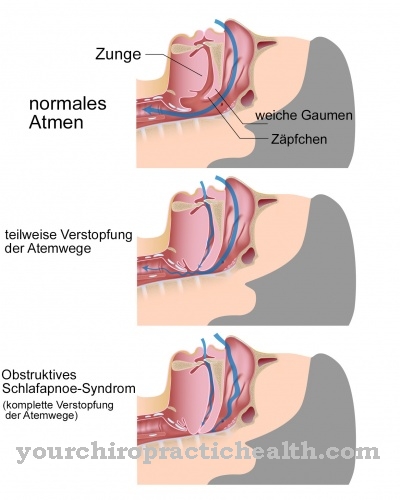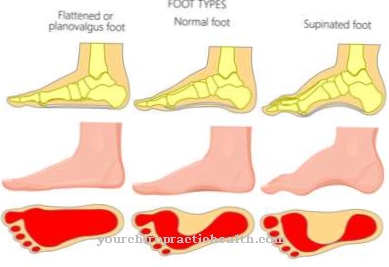Around 50 to 70 percent of all women of childbearing age will suffer from one at some point in their life Uterine fibroid. Fibroids are also the most common cause of hysterectomy at this age.
What is a uterine fibroid?
The term Uterine fibroid, also as Uterine tumor stands for a benign tumor in the uterine muscle layer. Myomas consist partly of connective tissue and can grow up to several centimeters in size. As growth progresses, they can even fill the entire uterus, as in pregnancy.
A uterine fibroid is a hormone-dependent tumor and is stimulated to grow by estrogen. Therefore, growth depends on the proper functioning of the ovaries, in which the sex hormones are produced. This is why uterine fibroids only occur when a woman is of childbearing age and usually regress slowly during the menopause.
causes
Exactly how a uterine myoma develops has not yet been adequately researched, but it is considered certain that there is a connection between the estrogen balance and the occurrence of hormones. The benign tumor arises from cells of the muscles in the uterus. They are not unlikely to arise from a surge of energy that the body normally intended for pregnancy.
There also seems to be a genetic predisposition because uterine fibroids occur more often in families in which the mother had fibroids. It is also known that high levels of estrogen promote the growth of fibroids and that they mainly appear during the fertile period. Fibroids do not appear before puberty, and they regress again after menopause.
Symptoms, ailments & signs
The symptoms and complaints caused by a fibroid depend to a large extent on the size of the fibroid and whether one or more fibroids are present. Prolonged menstrual periods can occur, and the bleeding rate mostly depends on the size and location of the fibroid. In some women, the increased bleeding can cause anemia.
Other symptoms can include pressure and discomfort in the abdomen because the fibroid can press on other organs. In the bladder, this can lead to an increased urge to urinate or problems with emptying the bladder. When the fibroid presses on the rectum, constipation is encouraged. Problems during sexual intercourse are also common.
Women with fibroids and wanting to have children often fail to conceive because the fibroid can prevent the fertilized egg cell from implanting in the uterus. If fibroids grow during pregnancy, they can cause miscarriage, pregnancy discomfort, and premature labor.
Diagnosis & course of disease
In most cases, uterine fibroids are detected during a pelvic exam. Sometimes the anamnesis interview already gives rise to suspicion. The conversation is followed by a physical examination, and if a fibroid is suspected, an ultrasound scan, during which fibroids can be easily recognized. Size and location can also be precisely determined in this way.
In addition, other tests such as magnetic resonance imaging (MRI) or computed tomography (CT) can sometimes be performed, especially if fibroids have to be surgically removed. A hysteroscopy allows fibroids that protrude into the uterus to be examined more closely.
If they grow into the abdomen, a laparoscopy can help. In most cases, however, this is not necessary. It is not easy to differentiate benign uterine tumors from malignant ones. In most cases a tissue examination is necessary for this.
Complications
A uterine fibroid is usually harmless and does not cause any further symptoms. Complications can occur if a so-called uterus myomatosus occurs, i.e. the uterine wall is penetrated by numerous myomas. This increases the risk of malignant degeneration, which occurs rarely with classic uterine fibroids (less than one percent of all those affected).
A uterine fibroid also promotes urinary tract infections and occasionally causes pain when urinating. If the fibroid presses on the bladder or ureter, dysfunction can occur. Infestation of the intestines and kidneys also carries the risk of a sensitive disruption of organ function. A pedunculated suberous myoma can lead to a sudden twist of the stem, associated with severe pain and serious complications that require rapid surgery.
In the long term, uterine fibroids can cause fertility problems. If the growth occurs during pregnancy, there is a risk of premature labor. From a certain size, fibroids can also cause positional anomalies in the child. If the uterine fibroid lies directly under the lining of the uterus, it can trigger an ectopic pregnancy or miscarriage.
There are typical risks associated with surgical or drug removal. Surgery can always lead to infections and injuries. Drug therapy is associated with the risk of side effects and interactions.
When should you go to the doctor?
With a uterine fibroid, the person concerned is usually always dependent on medical treatment from a doctor. Since this disease cannot cure independently, a doctor must be contacted as soon as the first signs and symptoms appear so that there are no further complications. An early diagnosis usually has a positive effect on the further course. A doctor should be consulted for uterine fibroids if the woman suffers from a significantly prolonged menstrual period. This can also come very irregularly, which can have a negative effect on the psyche.
Many women also suffer from anemia as a result of the disease. In many cases, severe pain in the abdomen or pain during intercourse can also indicate the disease and should also be evaluated by a doctor. Some women continue to experience painful urination. A uterine fibroid can be treated by a general practitioner or by a gynecologist. As a rule, this disease can be treated well so that there are no further complications and also no reduced life expectancy for those affected.
Treatment & Therapy
If there are no symptoms, fibroid treatment is not absolutely necessary, but a check-up should be carried out approximately every six to twelve months. In the case of complaints, the therapy depends on various factors such as the age of the woman or the question of whether there is still a desire to have children or whether family planning is complete. The size and location of the uterine myoma is also decisive.
Fibroids can basically be treated with different methods: surgically, with drugs or newer methods such as embolization or focused ultrasound. For younger women, uterine-retaining measures are preferred; for older women who have completed family planning, the most common therapy is usually removal of the uterus (hysterectomy).
In drug treatment, progestins are usually used for treatment, which reduce the body's own estrogen production and are supposed to inhibit myoma growth so that the symptoms decrease. If a fibroid is very small and you still want to have children, there is also the option of peeling off individual fibroids, either with a small abdominal incision, vaginal or laparoscopic surgery.
During embolization, the blood vessels are closed, which ideally leads to the regression of the myoma. With focused ultrasound, rays are aimed at the place where the fibroid is located. The myoma is said to die off as a result of the heat generated. However, this procedure is still new, very expensive and is often not reimbursed by health insurance companies.
You can find your medication here
➔ Medicines for menstrual crampsprevention
A meaningful prevention is not possible with a uterine fibroid. Women of childbearing potential should attend regular check-ups so that fibroids can be detected at an early stage. Early treatment can prevent worse symptoms from undetected fibroids. Even if an operation has been performed, it does not mean that fibroids can no longer occur. They can grow again and again because they are located in the muscles of the uterus. Only surgery can prevent new growth.
Aftercare
As a rule, uterine fibroids are not treated because they are usually small and cause no discomfort. However, it is monitored regularly and consistently in the course of follow-up care. Usually the affected women should go to the gynecologist for check-ups at intervals of about three to six months. The attending doctor will decide on the exact time intervals.
In exceptional cases, shorter or longer intervals between follow-up examinations are necessary. This mainly depends on any previous gynecological illnesses. As part of these controls, one examines whether the uterine myoma is growing and possibly affecting other organs. On the other hand, the potential development of a malignant tumor should be recognized in good time.
However, this only happens in extremely rare cases. Usually, the gynecologist will perform both a palpation exam and an ultrasound scan. Other measures such as blood tests are rarely used. Strict follow-up examinations are also necessary after surgical removal of a uterine fibroid.
In the first few weeks after the operation, these are used to remedy any subsequent symptoms of the operation. In addition, as part of quarterly or half-yearly check-ups with the gynecologist, whether new uterine fibroids may develop. The procedure is similar to that already described.
You can do that yourself
Uterine fibroids do not necessarily have to be treated. If clinical symptoms arise, the gynecologist should be consulted. The individual therapy options can be supported by those affected by self-help measures.
In the case of drug therapy, the medication should primarily be taken. Any hormonal complaints should be reported to the doctor. Affected women should also take it easy and pay careful attention to possible side effects and interactions. Drug treatment usually takes place in preparation for an operation. After an operation, it is important to take care of yourself. Natural herbal medicinal products help with persistent pain, such as pain-relieving teas with valerian or cooling and warming pads that are placed on the lower abdomen.
If the fibroids are treated with focused ultrasound, no further self-help measures are necessary. The most important thing to do is to observe the physical symptoms. After one to two weeks, the gynecologist must be consulted again. If the fibroid has shrunk as desired, the treatment can be repeated.
In addition, general relaxation measures help to reduce the stress of the treatments and to improve well-being beyond the therapy. Inform your doctor if you have persistent intermenstrual bleeding or pain.



























